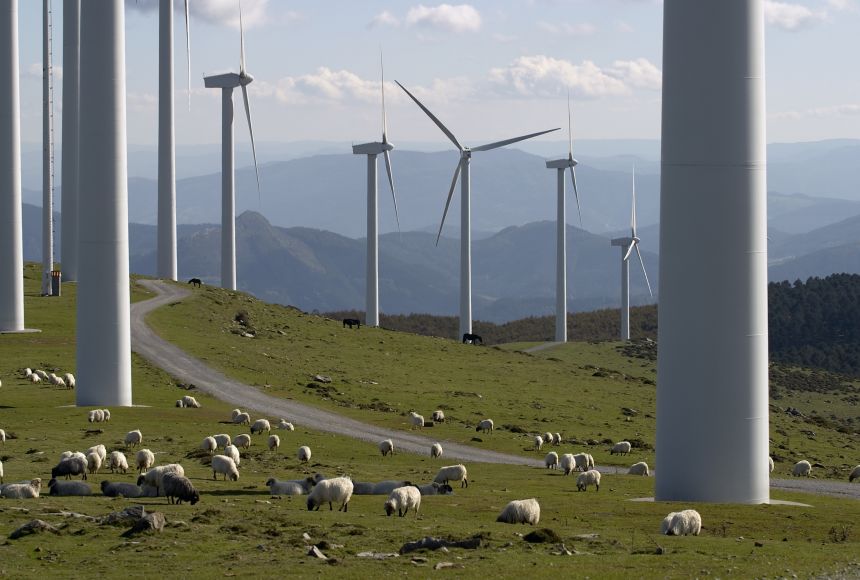An energy source that does not get used up is called renewable energy. The wind, the sun, and heat from Earth are sources of renewable energy.
Solar Energy
Solar energy comes from the sun.
Active solar energy uses special technology to capture the sun's rays. The two types are photovoltaic cells (PV cells or solar cells) and mirrors. They focus sunlight in a specific spot to generate electricity. PV cells last for a long time and are efficient.
Passive solar energy does not use equipment. Energy comes from the way sunlight naturally changes throughout the day. One example is building a house such that it faces the sun more often and thus gets more heat from it.
There are reasons why solar power cannot be used as the only power source in a community. It can be expensive to install PV cells or build a building using passive solar technology.
Also, sunshine is hard to predict. The sun can get blocked by clouds. Different places get different amounts of sunlight based on the location, time of year, and time of day.
Wind Energy
Throughout history, people have been harnessing the wind's energy. Ancient Egyptians made boats powered by the wind more than 5,000 years ago. In 200 B.C.E., people used windmills to grind grain in the Middle East and pump water in China.
Today, we capture the wind's energy with wind turbines. These are large towers with two or three blades at the top. The wind turns the blades, and the blades turn a generator located inside the tower. This creates electricity.
Groups of wind turbines are known as wind farms. Wind farms can be found near farmland, in narrow mountain passes, and even in the ocean. Wind turbines anchored in the ocean are called offshore wind farms.
Steady winds can provide cheap, reliable electricity. Turbines do not emit pollutants into the air. But wind speed changes constantly, depending on the time of day, weather, and geographic location. They are also dangerous for bats and birds, as they can crash into them.
Geothermal Energy
Geothermal energy makes use of the extreme heat of the earth's core. The center of the Earth is extremely hot. It's thought to be over 6,000 degrees Celsius (about 10,800 degrees Fahrenheit). The heat is constantly moving toward the surface.
We can access underground geothermal heat in different ways. One way is to use geothermal heat pumps. A pipe of water loops between a building and holes dug deep underground. Geothermal energy warms water underground. Then the warmth moves aboveground to the building. Geothermal heat pumps can be used to heat houses, sidewalks, and even parking lots.
Another way to use geothermal energy is with steam. In some areas of the world, there is underground steam that naturally rises to the surface. The steam can be piped straight to a power plant. However, in other parts of the world, the ground is dry. Water must be injected underground to create steam. When the steam comes to the surface, it is used to turn a generator and create electricity.
In Iceland, there are large reservoirs of underground water. Almost 90 percent of people in Iceland use geothermal as an energy source. They heat their homes and businesses.
Biomass Energy
Biomass is any material that comes from plants, animals, or microorganisms that were recently living. Plants create energy from the sun through a process called photosynthesis. This energy is stored in the plants even after they die.
Trees, branches, scraps of bark, and recycled paper are common sources of biomass energy. Manure, garbage, and crops, such as corn, soy, and sugar cane, can also be used as biomass feedstocks.
We get energy from biomass by burning it. Wood chips, manure, and garbage are dried out and compressed into squares called briquettes. These briquettes are so dry that they do not absorb water. They can be stored and burned to create heat or generate electricity.
Biomass can also be converted into biofuel to power cars and trucks. Biofuels are mixed with regular gasoline and can be used to power cars and trucks. Biofuels release less harmful pollutants than pure gasoline.
Biomass can be stored and used when it is needed. However, growing crops for biofuels requires large amounts of land and pesticides.
Hydroelectric Energy
Hydroelectric energy is made by flowing water. Most hydroelectric power plants are located on large dams, which control the flow of a river.
Dams block the river and create an artificial lake, or reservoir. A controlled amount of water is forced through tunnels in the dam. As water flows through the tunnels, it turns huge turbines and generates electricity.
Hydroelectric energy is inexpensive and reliable. Water is constantly flowing, so the dam does not depend on the weather and time of day.
However, hydroelectric power plants are damaging to the environment. When a river is dammed, it creates a large lake behind the dam. This lake drowns the original river habitat and sometimes drowns entire towns. Silt, or dirt from a riverbed, can build up behind the dam. It can damage the dam, shortening its life span.
Other Renewable Energy Sources
Scientists and engineers are working to harness other renewable energy sources. Three of the most promising are tidal energy, wave energy, and algal (or algae) fuel.
Tidal energy uses the power of ocean tides to generate electricity. Moving tides turn the blades of a turbine. Other projects use reservoirs that are filled at high tide and slowly release the water and turn turbines at low tide.
Wave energy harnesses waves from the ocean, lakes, or rivers. Some use the same kind of equipment as for tidal energy.
Algal fuel is a type of biomass energy that uses the unique chemicals in seaweed to create a clean and renewable biofuel. Algal fuel does not need the acres of cropland that other biofuel feedstocks do.
